Cheesecake is one of those desserts you can hardly ever say no to. We spend hours perfecting the batter and bake. Even then, some home bakers might often be disappointed at the cracks denting the tops of their labor of love. You might think, why did my cheesecake crack?
But many at-home bakers have had to see a few cracked cheesecakes in time baking these delicious treats. Pulling a cheesecake that is cracked at the top is a sad slight, one most feel disheartened by. I’m going to tell you why you get the cracks at the top and what you can do to prevent it from happening.
Come on now, let’s get on with some beautiful looking and delicious cheesecakes!
Reasons They Crack at the Top
I am going to give you a list of reasons why you get the small or big cracks at the top of your cheesecake. This will help you understand the whole process a lot better.
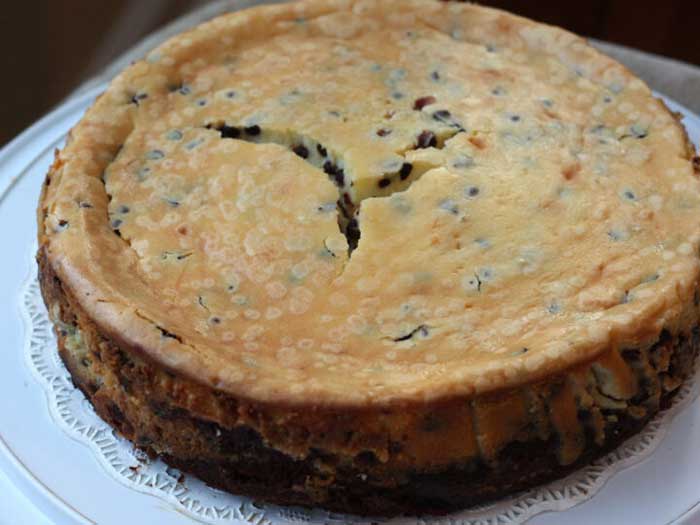
Natural Way of Expanding
At first, let’s talk about the reason we might not have much control over. When cheesecakes bake, they tend to expand. It is how they are supposed to cook. And sometimes, they expand a bit too much and have too much air inside, so when it cools, there is a lot of shrinkages. This causes the top to crack.
To be honest, you don’t really have much control over how much the cheesecake is going to expand. But when adding in the ingredients, you have to be a little mindful about what you’re adding in. And to make sure it is baked properly.
But don’t worry. This does not happen all that often. It is a very rare occurrence that you might never even have to deal with to bake the cheesecake in the correct way.
Forgot the Water Bath
You may not have known before, but cheesecakes tend to dry up very easily. As they become dry, they crack at the top due to the lack of moisture. This is why the baking tin or dish is usually placed in a tray of water. This is what we call a water bath.
When the cheesecake bakes and the oven becomes hot, steam is created inside from the water, this helps the cheesecake to bake properly, and the steam adds moisture. It also stops the cheesecake from drying out during the baking process, and you will not see a cracked top.
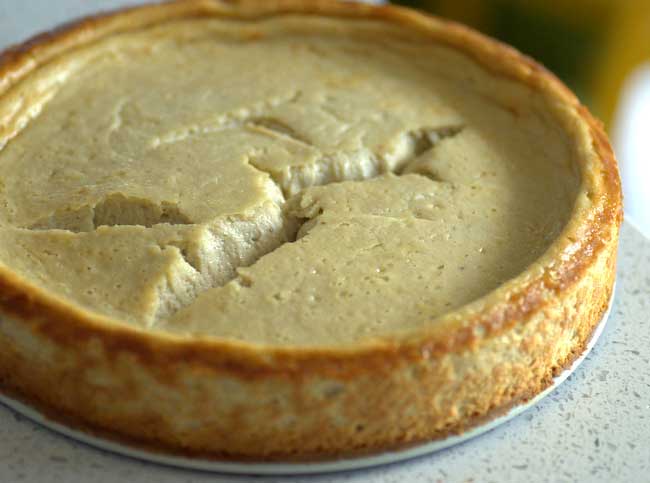
Another reason why we tend to use a water bath for the cheesecake is to make sure it is cooked slowly at an even temperature throughout. Just the heat from the oven is a bit harsh, and this can very quickly overcook the dish. Therefore, by adding steam in, you will get a slower cooking process, but it is more efficient.
The Batter Dries out
If you think about the things you add into your cheesecake mixture, you will see that eggs are one of the most important elements. The batter is almost custardy because of the eggs, and as you might have seen while cooking eggs, they dry up very fast when they are overdone.
So when the cheesecake has been inside the oven for a very long time. Or if the temperature is too high, then there is a very high chance that the eggs inside the batter are going to dry out. What happens is, it automatically strips the filling of moisture as well. This is when you will see the crack in your cheesecake.
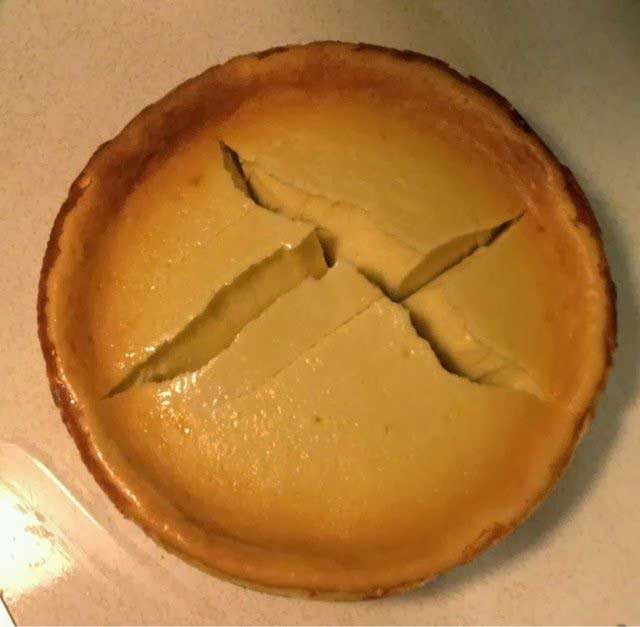
Make sure you are not over baking your cheesecake and make sure your oven is at the right temperature. Cook it for 50-60 minutes at 320 degrees. When you take the cheesecake out of the oven, there should be a slight jiggle to it, but not too jiggle. You don’t want it underbred either, as it won’t hold its shape.
Over-Mixing the Filling
When you mix the ingredients in the cheesecake with an electric mixer, you tend to incorporate a lot of air bubbles in the batter. So, when to pop it in the oven, the cheesecake filling rises a lot. This leads to a drastic shrinkage after it has had a little time to rest and cool.
So this is something you have to keep in mind while making cheesecake, there is no need to over beat the ingredients. The whipping cream obviously needs to be whipped, and you need to soften the cheese in with the sugar. But other than the absolutely necessary steps, try to use a spatula and fold the eggs in with the mixture.
Whipping the whites in the egg can add in a lot of air. Therefore, mix until it has mixed in properly with everything else. That should be enough for the cheesecake.
Fluctuation in Temperature
You might do everything right, starting from your batter to the amount of time to bake the cheesecake. But there is still a chance your cheesecake will crack, and that happens when it goes through a change in temperature. If you like in a warm and humid place, then you don’t have anything to worry about.
But if the area where you’re cooking is very cold, then the change in the temperature will cause the top of the cheesecake to crack. Also, you are not supposed to take the cheesecake out of the oven and put it in the fridge, let it slowly cool down outside first and then put it in the fridge.
Slipping It out of the Pan
I have said this before, but I am going to say it again. You must let the cheesecake rest for a little while before you start messing around with it. When it is hot, it is still very fragile, and the chances of it breaking or checking when you are about to take it out of the pan are very high.
Also, the cheesecake is going to shrink a little when it cools down. This is when it will pull away from the pan, so you will have a much easier time pulling it out. One thing you must remember is to use a knife to release the sides from the pan. If it is stuck, then the cheesecake might get pulled at, which will cause a crack.
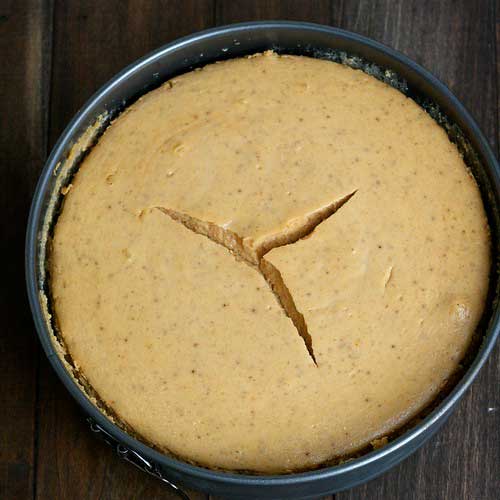
So now you know all the reasons why you might have a cracked cheesecake, you also know what to do in order to prevent the cracks from happening in the first place. But sometimes you might miss out on something, and you might have a defected cheesecake.
Don’t worry. I have a few tricks up my sleeve, which will get you out of the mess.
How to Salvage a Cheesecake with Cracked Top
If you have a cracked cheesecake in your hand, don’t worry. You just have to take certain steps that will make things right again.
Add a Layer of Topping
If you have cracks in several places on your cheesecake, then the easiest way for you to get rid of it would be to add some type of topping. The easiest would be to whip up some whipping cream and layer it on top of the cheesecake. This will hide the crack completely, and you will have a beautiful looking dessert in the end.
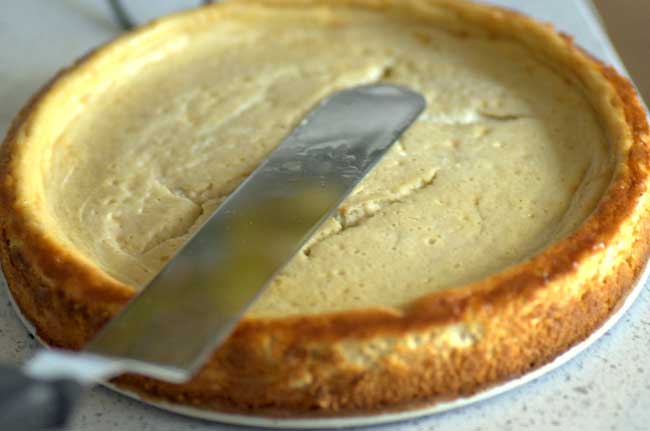
You could also try making some type of fruit jelly, puree, or even fresh fruits to hide the areas where the cracks are visible. These will make the cheesecake look even more appetizing, and the little mishap will go unnoticed by your guests.
Push the Batter down
As you know, the filling in the cheesecake is usually very soft and playable. So, if you do see a crack on your cheesecake, then you can actually push it down and make things even again. Your cheesecake will not look perfect because the pressed down a bit might have a matted texture, but the idea here is to even it out.
And you are recommended to use an offset spatula for this, and this provides you with an even and large surface area to work with. Also, it will help you with placement. As you push down, you will see the cracks getting filled up on its own. This method is very useful id the crack is big.
Run a Hot Spatula and Fix the Crack
If you see a few little cracks on your cheesecake, then you can very easily get rid of them. All you have to do to make them vanish it melt parts of the top layer of the cheesecake using a hot spatula. The heat from the spatula will make it easier for you to manurer the cheesecake filling, and with that, you should be able to get it of cracks.
However, this will not work with bigger cracks.
Final Words
We all make a mistake while baking; sometimes, you just need the right tricks to deal with whatever is to come. And it’s very important not to get disheartened. Everyone has seen a few cracked cheesecakes in their lives.

